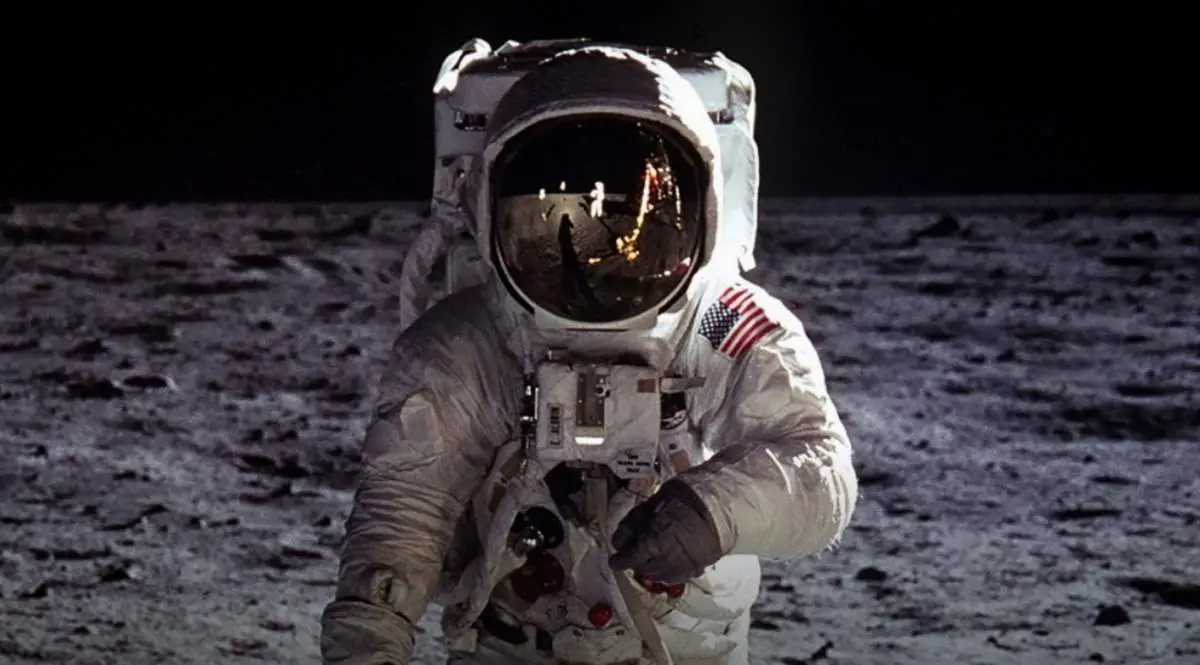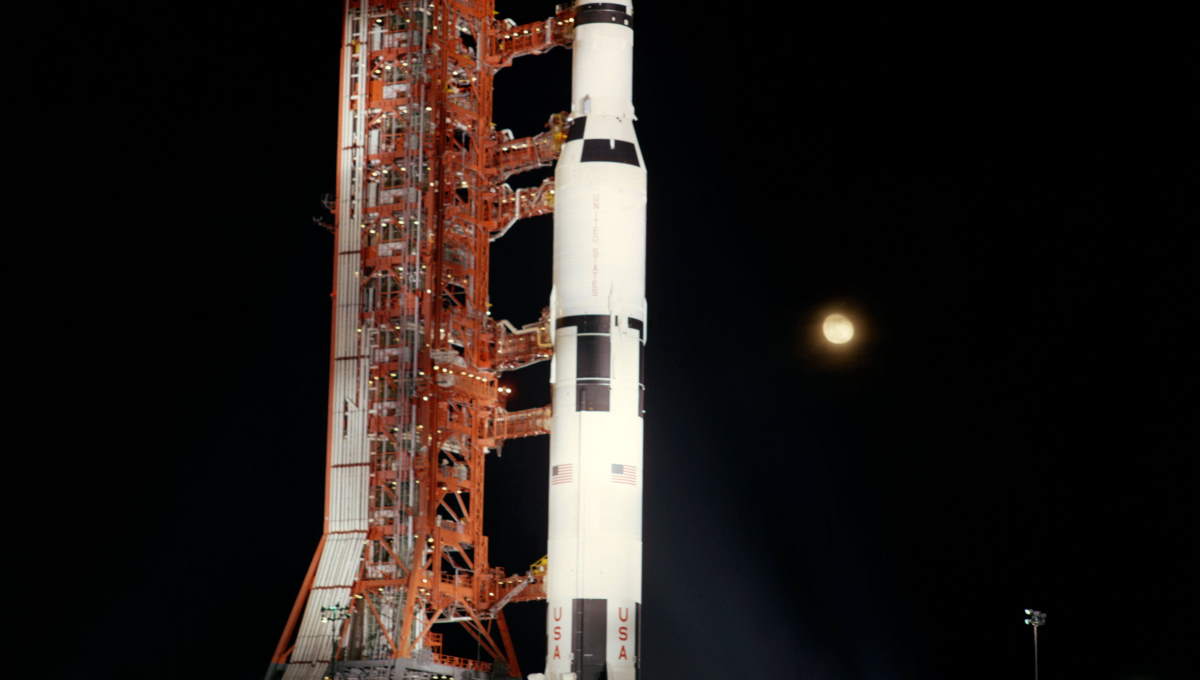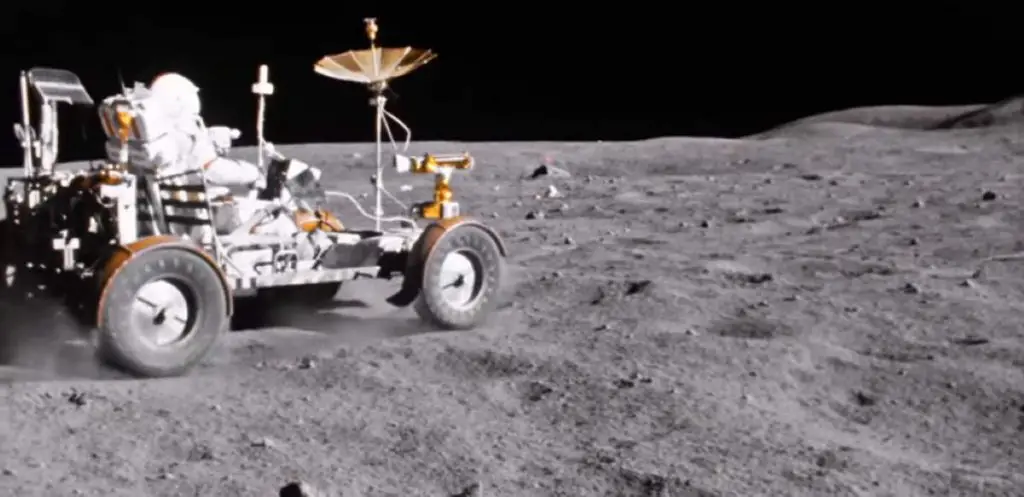In the history of Space Exploration, numerous space missions have been undertaken to study the Moon, the Earth’s natural satellite. Here’s the list of successful moon landings (crewed and uncrewed) with dates and mission summaries.
As of March 2025, there were a total of 27 (6 crewed and 21 uncrewed) successful or partially successful moon landings. Only five countries achieved a soft lunar landing:
- United States: 13 (6 crewed and 7 uncrewed) successful moon landings
- Soviet Union: 8 successful uncrewed moon landings
- China: 4 successful uncrewed moon landings
- India: 1 uncrewed successful moon landing
- Japan: 1 uncrewed partially successful moon landing
List of successful moon landings
Crash landings, impactors, and failed missions are not included.
1. Luna 9 [USSR, February 3, 1966, uncrewed]: The first successful moon landing
Before astronauts ever set foot on the Moon, the Soviets, and Americans both sent fleets of robotic spacecraft to scout and pave the way.
Soviet Union’s Luna 9 was the first spacecraft to achieve a moon landing, and, in general, survivable landing on a celestial body. It was launched on January 31, 1966, successfully landed on the Moon on February 3, and remained operational for 3 days. On 6 February at 22:55 UT, the batteries ran out of power and the mission ended.

2. Surveyor 1 [NASA, June 2, 1966, uncrewed]
Surveyor 1 was the first American spacecraft to perform a successful moon landing. It was launched on May 30, 1966, and landed in Oceanus Procellarum (the largest “mare” or “sea” on the moon) on June 2.
Over a period of about 30 days, Surveyor 1 transmitted more than 11,000 photographs as well as data on the moon’s surface and temperature.
3. Luna 13 [USSR, December 24, 1966, uncrewed]
Luna 13 was launched on December 21, 1966, and performed a soft landing on the Moon in Oceanus Procellarum on December 24.
Luna 13 was almost identical to Luna 9, the spacecraft that first performed a successful moon landing, except for some structural changes made in response to the experience gained from the Luna 9 mission and the addition of some experiments.
Luna 13 not only returned 5 panoramic photos of the landscape at different sun angles but also measured the lunar soil’s physical and mechanical properties and its radiation characteristics.
One of the two cameras intended to create stereo images failed, though, but the pictures the working camera provided were good.
On December 31, a TASS (Russian News Agency) communique announced that Luna 13 had completed its mission.
4. Surveyor 3 [NASA, April 20, 1967, uncrewed]
Surveyor 3 was launched on April 17, 1967, and landed on April 20, 1967, at the Mare Cognitum portion of the Oceanus Procellarum.
The probe conducted experiments to see how the lunar surface would fare against the weight of an Apollo lunar module.
It transmitted 6,326 TV images to the Earth, including the first images to show what planet Earth looked like from the Moon’s surface.
Surveyor 3 returned the last data on May 4, 1967, at 00:04 UT. The moon probe failed to come back to life after the two-week lunar night.
On 19 November 1969, the Apollo 12 Lunar Module (LM) landed within about 180 meters (590 feet) of the Surveyor 3 spacecraft. Astronauts Pete Conrad and Alan Bean visited the spacecraft on their second moonwalk on November 20, examining Surveyor 3 and its surroundings and taking photographs.
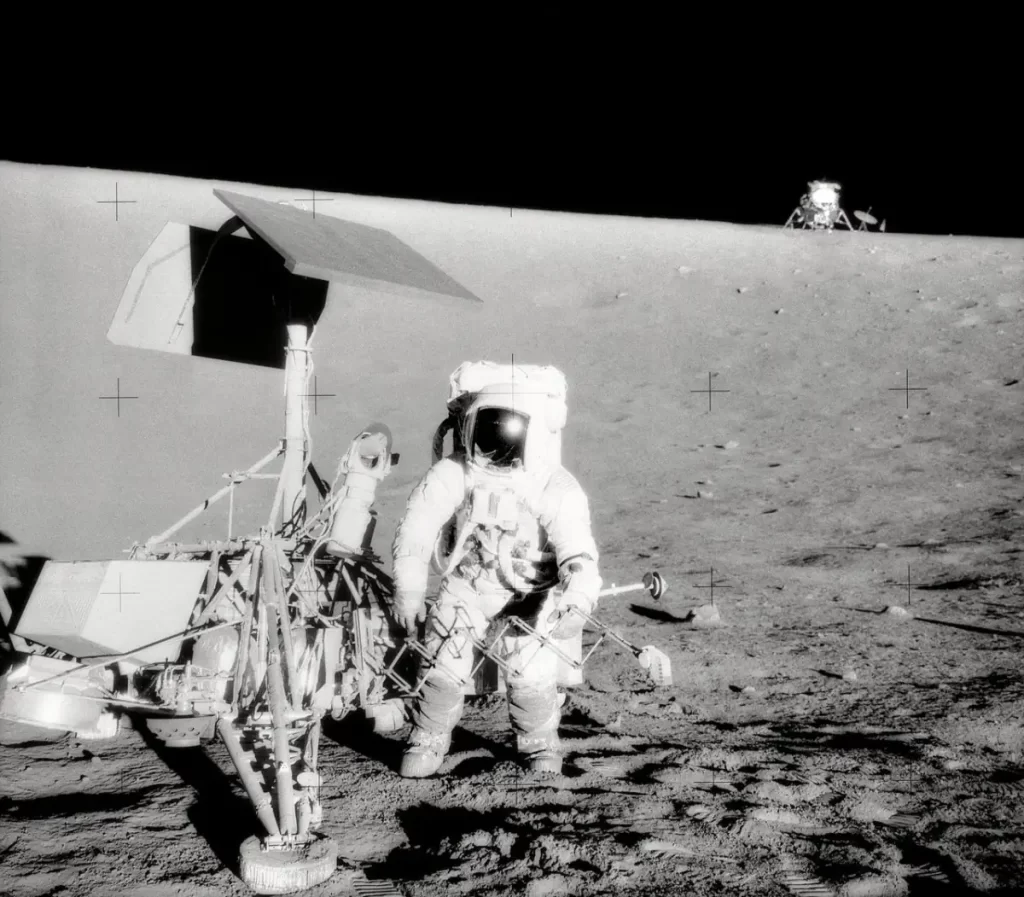
The astronauts removed about 10 kg of parts from Surveyor 3, including the soil scoop and camera system, and brought them back to Earth. Scientists were then able to study the effects of years of exposure on the Moon’s surface.
The Surveyor 3 camera is now on display in the Smithsonian National Air and Space Museum in Washington, D.C.
5. Surveyor 5 [NASA, September 11, 1967, uncrewed]
Surveyor 5 was launched on September 8, 1967, and landed on the Moon on September 11, at the Mare Tranquillitatis.
It was the third spacecraft in the Surveyor series to achieve a successful moon landing.
Surveyor 5’s alpha-scattering instrument performed the first in-situ analysis of an extraterrestrial body and provided data on lunar soil composition.
Unlike Surveyor 3, Surveyor 5 survived three lunar nights: it was shut down from September 24 to October 15 over the first lunar night. On October 18, Surveyor 5 acquired thermal data during a total eclipse of the Sun. Transmissions for the second day were received until November 1, 1967, when the shutdown for the second lunar night occurred about 200 hours after sunset. Transmissions were resumed on the third and fourth lunar days, with the final transmission occurring on December 17, 1967.
Surveyor 5 transmitted a total of 19,118 photos to the Earth. Some of them were images of the spacecraft’s original landing footprint, which helped scientists determine the lunar soil’s mechanical properties.
6. Surveyor 6 [NASA, November 10, 1967, uncrewed]
Launched on November 7, 1967, NASA’s Surveyor 6 performed another successful moon landing on November 10, 1967.
It has a payload virtually identical to that of Surveyor 5. The main differences were that Surveyor 6 had polarizing filters on the TV camera, a different type of glare hood, and had 3 auxiliary mirrors instead of 2.
The spacecraft had a mass of 1006 kg (2217.85 lbs) at launch and 299.6 kg (660.5 lbs) on landing.
Surveyor 6 performed the first-ever powered takeoff from the lunar surface: on November 17, at 10:32 UT, the spacecraft fired its engines for 2.5 seconds, lifted off the lunar surface 3-4 meters (10-13 feet), and landed about 2.4 meters (8 feet) west of its original position.
This small lunar “hop” provided valuable information on the effects of firing rocket engines on the Moon to NASA scientists.
Surveyor 6 sent its last useful data to Earth on November 24. The last contact with the spacecraft was established on December 24.
Overall, Surveyor 6 transmitted 29,952 images to Earth.
7. Surveyor 7 [NASA, November 10, 1968, uncrewed]
The final Surveyor mission (the fifth to achieve a lunar soft landing), Surveyor 7 was launched on January 7, 1968, and performed a successful moon landing on January 10.
Mission objectives were:
- Performing a lunar soft landing
- Obtaining post-landing TV pictures
- Determining the relative abundances of chemical elements;
- Manipulating the lunar material
- Obtaining touchdown dynamics data
- Obtaining thermal and radar reflectivity data.
Surveyor 7 was the only Surveyor craft to land in the lunar highland region.
The lander operated until February 21, 1968, when the last contact occurred.
8. Apollo 11 [NASA, July 20, 1969, the first crewed landing on the Moon]
On July 20, 1969, Apollo 11 astronauts Neil Armstrong and Buzz Aldrin performed the first crewed moon landing. The third crewmember, Michael Collins remained in lunar orbit.
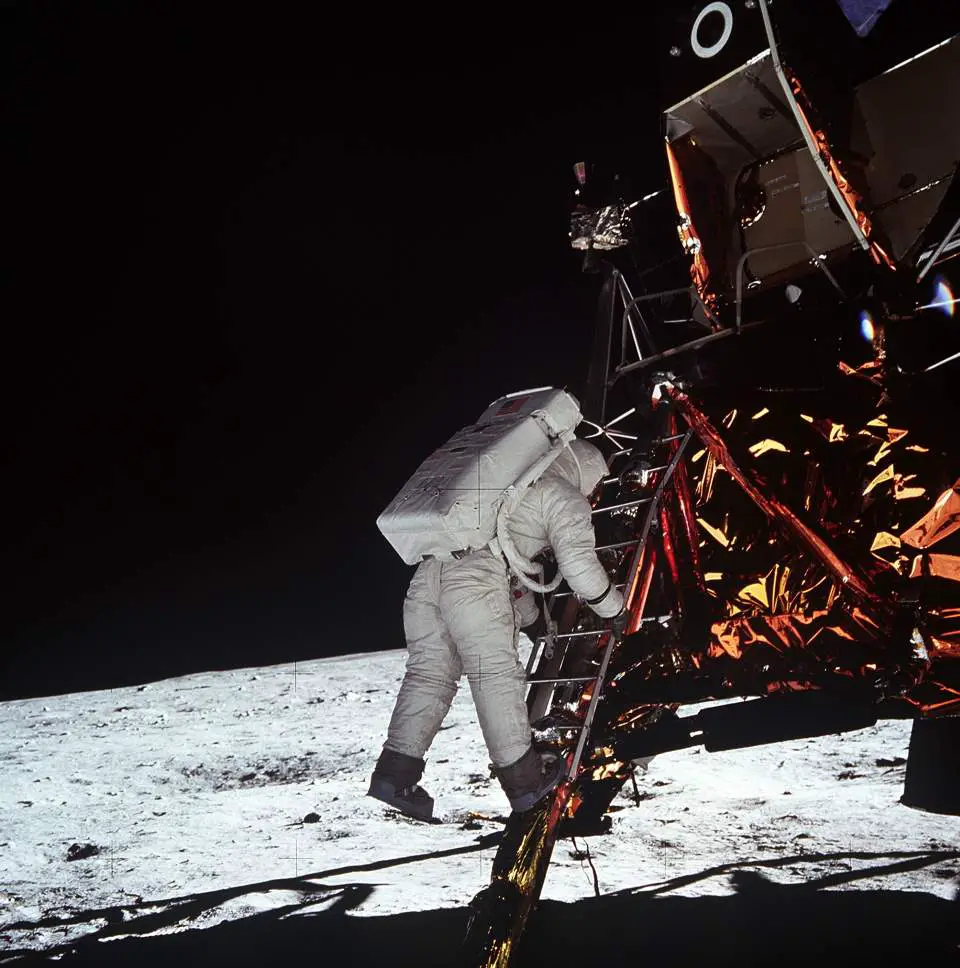
9. Apollo 12 [NASA, November 19, 1969, crewed]
Launched on November 14, 1969, and landed on the Moon on November 19, 1969, Apollo 12 was the sixth crewed flight in the United States Apollo program and the second to land on the Moon, just five months after Apollo 11.
The crew was: Charles (Pete) Conrad, Jr., the commander; Richard F. Gordon, the command module pilot; and Alan L. Bean, the lunar module pilot.
10. Luna 16 [USSR, September 20, 1970, uncrewed]
Luna 16 was the first robotic probe to land on the Moon and return a sample to Earth. It launched on September 12, 1970, and performed a successful moon landing on September 20, 1970. This was the first landing when it was night on the moon (not to be confused with landing on the far side of the moon).
After 26 hours and 25 minutes on the lunar surface, the ascent stage, with the hermetically sealed (a hermetic seal is any type of sealing that makes a given object airtight) soil sample container, lifted off from the Moon carrying 101 grams of collected material on September 21.
The Luna 16 re-entry capsule returned directly to Earth without any mid-course corrections, made a ballistic entry into the Earth’s atmosphere, and landed 80 kilometers (50 miles) southeast of the town of Jezkazgan in Kazakhstan on September 24.
11. Luna 17 [USSR, November 17, 1970, uncrewed]
Luna 17 was launched on November 15, 1970, and performed a successful moon landing on November 17, 1970. It deployed the first robotic rover, the Lunokhod 1, onto the surface of the Moon.
The operations of Lunokhod officially ceased on October 4, 1971, the anniversary of Sputnik 1, the first artificial satellite.
Lunokhod 1 traveled 10,540 meters (34,580 feet) on the Moon’s surface and transmitted more than 20,000 TV pictures and more than 200 TV panoramas. It also conducted more than 500 lunar soil tests.
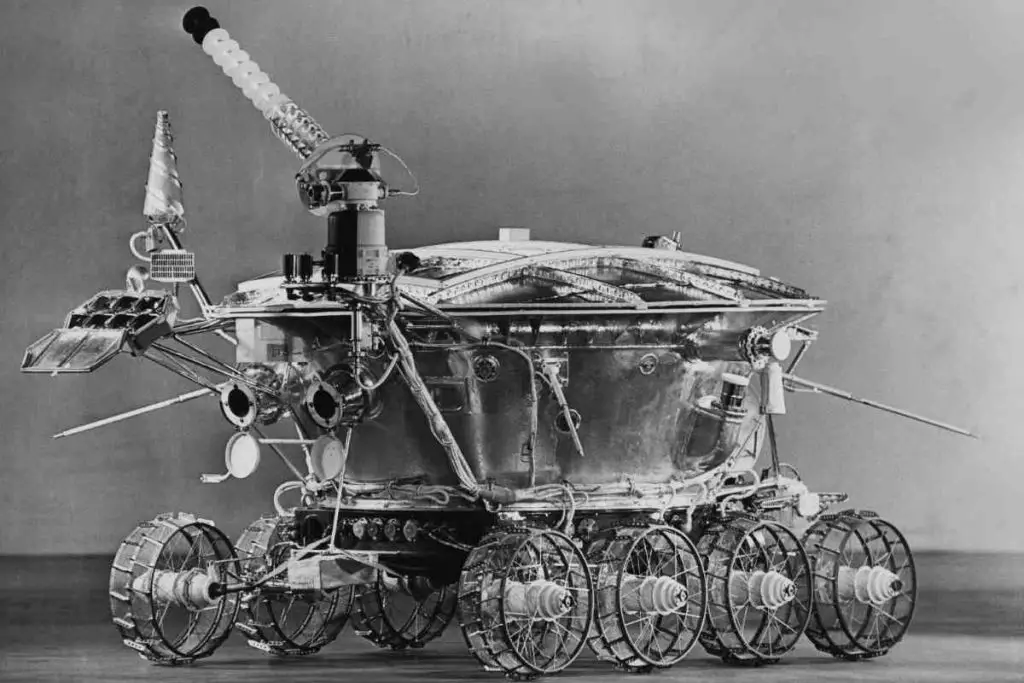
Related: Lunokhod 1
12. Apollo 14 [NASA, February 5, 1971, crewed]
Apollo 14, the eighth crewed mission in the United States Apollo program (the third to land on the Moon) was launched on January 31, 1971.
Astronauts Alan B. Shepard Jr. (commander) and Edgar D. Mitchell (lunar module pilot) landed on the Moon on February 5, 1971. The third crewmember, Stuart A. Roosa (command module pilot) remained in lunar orbit.
The crew performed a number of scientific experiments and performed two EVAs (extravehicular activity). During these EVAs, the astronauts collected 42.6 kg (94 pounds) of lunar rocks and soil for return to Earth.
The lunar module (named “Antares”) lifted off from the Moon on February 6. It docked with the orbiting command module (named “Kitty Hawk”) 1 hour and 47 minutes later.
The mission ended with a splashdown in the South Pacific Ocean on February 9, 1971.
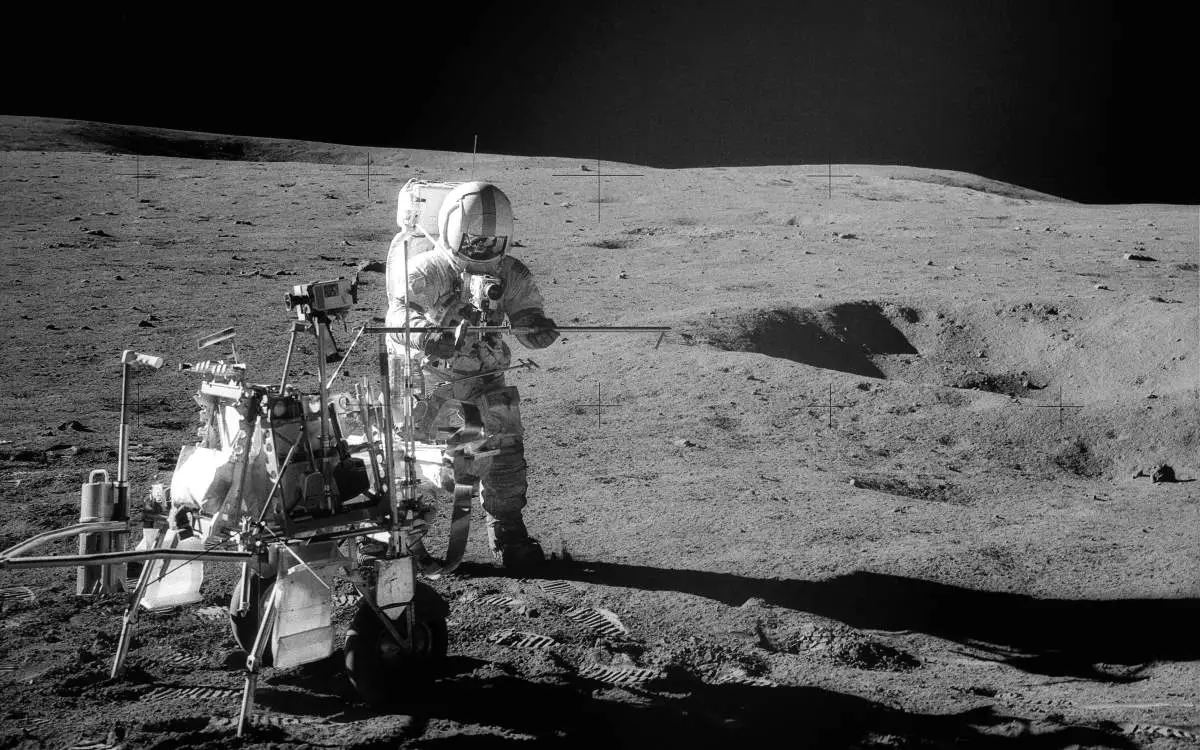
13. Apollo 15 [NASA, July 30, 1971, crewed]
Apollo 15 was the ninth crewed mission in the United States Apollo program, and the fourth to land on the Moon (after Apollo 11, Apollo 12, and Apollo 14).
It was launched on July 26, 1971, at 9:34 AM EDT from the Kennedy Space Center at Merritt Island, Florida. The crew was:
- Commander: David R. Scott (Third and last spaceflight)
- Command module pilot (CMP): Alfred M. Worden (Only spaceflight)
- Lunar module pilot (LMP): James B. Irwin (Only spaceflight)
Scott and Irwin performed a successful moon landing on July 30, 1971, while Worden remained in orbit.
The mission saw the first use of the Lunar Roving Vehicle.
Astronauts collected a total of 77 kg (170 lb) of lunar surface material during 18.5 hours of EVAs (Extravehicular activity) outside the Lunar Module named Falcon.
The crew also left a small aluminum statuette called “Fallen Astronaut” on the surface of the Moon.
The mission ended with a splashdown on August 7. During the descent, the spacecraft lost one of its three parachutes, but that caused no problem.
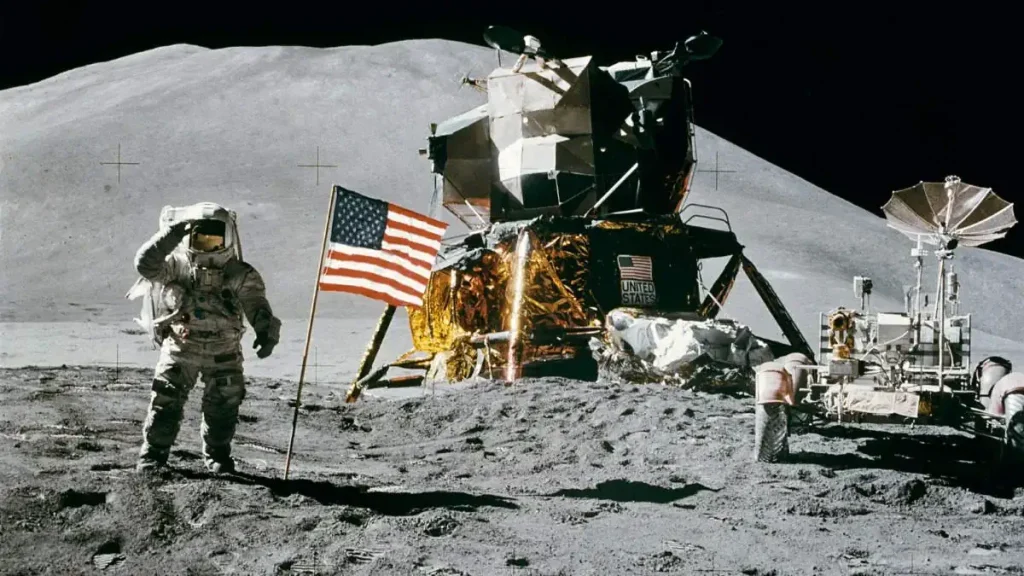
14. Luna 20 [USSR, February 22, 1972, uncrewed]
The second of three successful Soviet lunar sample return missions (the first was Luna 16 and the last was Luna 24), Luna 20 was launched on September 12, 1972, and performed a successful moon landing on February 22, 1972.
After collecting a small sample of lunar soil (30 grams), the spacecraft’s ascent stage lifted off from the lunar surface on February 22 and eventually parachuted down safely on an island in the Karkingir River, 40 kilometers (25 mi) north of the town of Jezkazgan in Kazakhstan, on February 25.
15. Apollo 16 [NASA, April 21, 1972, crewed]
Apollo 16, the tenth crewed mission in the Apollo program and the fifth and penultimate to land on the Moon, was launched on April 16, 1972, and performed a successful crewed moon landing on April 21, 1972.
Three crewmembers were:
- John W. Young (commander),
- Charles Duke (Lunar Module Pilot)
- Ken Mattingly (Command Module Pilot, stayed in Lunar orbit)
The mission’s primary objectives were:
- Inspecting, surveying, and sampling materials and surface features at a selected landing site in the Descartes region
- Emplacing and activating surface experiments
- Conducting in-flight experiments and photographic tasks from lunar orbit.
Additional objectives included a number of experiments requiring zero gravity and engineering evaluation of spacecraft and equipment.
During 71 hours and 2 minutes of surface stay, astronauts explored the region on three EVAs totaling 20 hours and 14 minutes.
Lunar liftoff came on time at 8:26 p.m. EST on April 23. While returning to Earth, Mattingly took an 83-minute spacewalk to retrieve several film cassettes from the exterior of the Service Module.
On April 27, 1972, at 19:45:05 UTC, the command module splashed down in the Pacific Ocean 350 kilometers (189 nautical miles) southeast of the island of Kiritimati 265 hours, 51 minutes, and 5 seconds after liftoff.

16. Apollo 17 [NASA, December 11, 1972, the last crewed moon landing mission]
The final mission of NASA’s Apollo program, Apollo 17 was launched on December 7, 1972.
While en route to the Moon, the crew took a photo of Earth from space, at a distance of about 45,000 kilometers (28,000 miles). This image, with the official NASA designation AS17-148-22727, became known as “The Blue Marble“, one of the most iconic photos of Earth from space.
Three-astronaut crew (Commander Eugene Cernan, Lunar Module Pilot Harrison Schmitt, and Command Module Pilot Ronald Evans) performed a successful moon landing on December 11, 1972.
Scientific objectives of the Apollo 17 mission include:
- Geological surveying and sampling of materials and surface features in a preselected area of the Taurus-Littrow region
- Deploying and activating surface experiments
- Conducting in-flight experiments and photographic tasks during lunar orbit and transearth coast.
The mission also included lunar sampling and lunar orbital experiments. Biomedical experiments included the Biostack II experiment and the BIOCORE experiment.
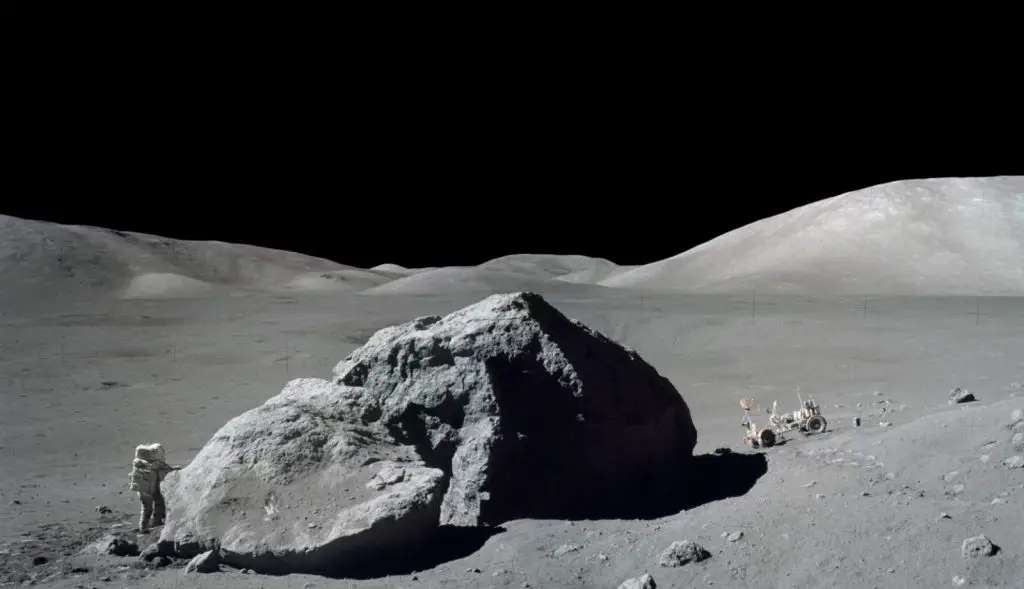
Three extravehicular activities (EVAs) lasted a total of 22 hours, and four minutes on the lunar surface.
The lunar rover vehicle traversed a total of 30.5 kilometers. Lunar surface-stay time was 75 hours, and lunar orbit time was 17 hours. Astronauts gathered 110.4 kilograms, (243 pounds) of material.
The Lunar Module (LM) ascent stage lifted off the moon on December 14. Apollo 17 splashed down safely in the Pacific Ocean on December 19.
Apollo 17 was the last crewed mission to the moon. It was also the last time humans traveled beyond the Low Earth Orbit (LEO, an altitude of less than 1000 km). The mission broke several records: the longest moon landing, longest total extravehicular activities (moonwalks), largest lunar sample, and longest time in lunar orbit.
17. Luna 21 [USSR, January 15, 1973, uncrewed]
Luna 21 was launched on January 8, 1973, and landed on the moon on January 15, 1973. It deployed a second robotic moon rover, the Lunokhod 2, and a French-made laser retroreflector.
On June 4, it was announced that the program was completed. The Lunokhod laser retroreflector is still used by Earth-based stations for laser ranging.
18. Luna 23 [USSR, November 6, 1974, uncrewed]
Soviet Union’s Luna 23 was launched on October 28, 1974, and performed a successful moon landing on November 6.
The spacecraft was intended to return a lunar sample to Earth, but, during landing in “unfavorable” terrain, the lander’s drilling device was evidently damaged, preventing fulfillment of the primary mission. Scientists had to improvise a makeshift plan to conduct a limited science exploration program with the stationary lander.
Controllers maintained contact with the spacecraft until November 9, 1974.
19. Luna 24 [USSR, August 18, 1976, uncrewed]
The last mission in the Soviet Union’s Luna program, Luna 24 was launched on August 9, 1976, and performed a successful moon landing on August 18. It was the third Soviet mission to retrieve lunar ground samples (the first two were returned by Luna 16 and 20).
Under command from ground control, the lander deployed its sample arm and pushed its drilling head about two meters (6.56 feet) into the nearby soil. The sample was safely stowed in the small return capsule, and Luna 24 lifted off successfully the next day at 05:25 UTC on August 19, 1976. It returned to Earth on August 22.
Luna 24 was the last spacecraft to make a soft landing on the Moon until the landing of China’s Chang’e 3 on December 14, 2013, 37 years later. For over 44 years, it was also the last Lunar sample return mission until China’s Chang’e 5 in December 2020.
20. Chang’e 3 [China, December 14, 2013, uncrewed]
Chang’e 3 was launched on December 1, 2013, and performed a successful moon landing on December 14.
It consisted of a robotic lander and China’s first lunar rover, designated Yutu (Jade Rabbit).
The successful landing makes China the third nation (After the USA and the Soviet Union) to land a robotic spacecraft on the moon and the second nation (after the Soviet Union) to use a robotic rover to explore the lunar surface.
The Yutu rover ceased to transmit data in March 2015 (it was designed to operate for approximately one year on the lunar surface). As of September 2022, the lander is still active and provides data.
21. Chang’e 4 [China, January 3, 2019, uncrewed, the first spacecraft to soft land on the far side of the Moon]
Launched on December 7, 2018, China’s lunar lander and rover Chang’e 4 achieved the first soft landing on the far side of the Moon in the history of humanity’s space exploration on January 3, 2019.
A lunar communications relay satellite, Queqiao, meaning “Magpie Bridge”, is a key component of Chang’e 4 moon landing mission. The satellite was launched to the Earth-Moon L2 point (see note 1) on May 20, 2018.
The lander also delivered a rover, Yutu 2, based on the Chang’e 3 Yutu (“Jade Rabbit”) rover.
As of September 2022, Chang’e 4 is still operational.
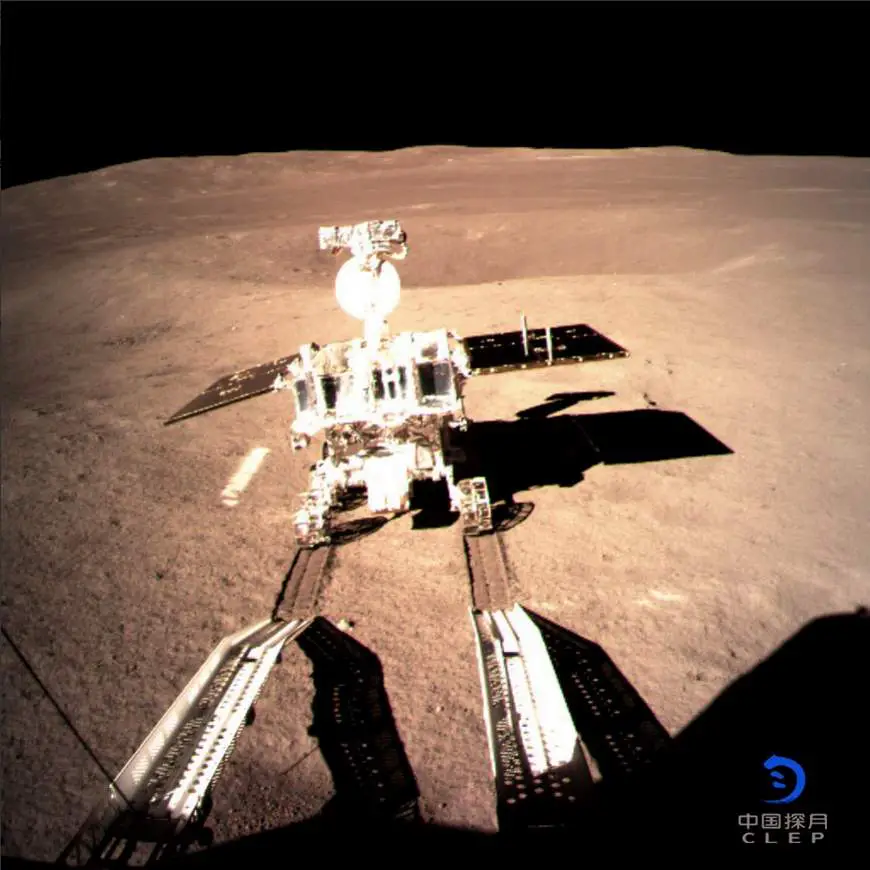
22. Chang’e 5 [China, December 1, 2020, uncrewed]
Change-5 represents China’s first mission to return moon samples to Earth. It was launched on November 23, 2020, and landed on the moon on December 1, 2020.
Following sample collection and storage, the sample container was placed by the robotic arm in the small ascender module of the lander, which lifted off from the lunar surface on December 3.
After an automatic lunar orbit rendezvous and docking with the Orbiter module, the samples were transferred to the lunar orbiter. The ascender deliberately crashed back on the Moon to avoid it becoming space debris.
The Orbiter left the lunar orbit and spent about 4.5 days flying back to the Earth orbit and released the Returner (reentry capsule) just before arrival. The returner capsule landed on Earth on December 16, 2020, carrying 1,731 grams (61.1 oz) of lunar samples.
23. Chandrayaan-3 [India, August 23, 2023, uncrewed]
India’s Chandrayaan-3 was launched on 14 July 2023. The lander and rover soft-landed near the lunar south pole region on 23 August 2023 at 5:34 am PT (6:04 pm IST). The powered descent took place on 23 August 2023, at approximately 5:45 pm IST.
This achievement places India as the fourth nation to achieve a soft lunar landing, following the former Soviet Union, the United States, and China. Furthermore, Chandrayaan-3 is the first moon mission to land on the lunar south pole, a yet-to-be-explored region.
24. Smart Lander for Investigating Moon (SLIM) [Japan, January 19, 2024, uncrewed]
The Smart Lander for Investigating Moon (SLIM), a mission by the Japan Aerospace Exploration Agency (JAXA), embarked on its lunar journey on September 6, 2023, at 23:42 UTC, which corresponds to September 7 at 08:42 Japan Standard Time. Following its launch, SLIM performed a crucial trans-lunar injection burn on October 1, 2023. The lander successfully entered lunar orbit on December 25, 2023, and achieved a soft landing on the Moon’s surface on January 19, 2024, at 15:20 UTC. This remarkable event marked Japan as the fifth nation to accomplish a soft landing on the Moon.
Accompanying SLIM were two Lunar Excursion Vehicles (LEV-1 and LEV-2), which were deployed just before the lander touched down on the lunar surface.
However, the mission encountered a hiccup with SLIM’s solar panels, which affected its power supply. The lander was left to operate solely on its battery reserves. Officials speculated that the solar panels might not have been oriented correctly to capture sunlight. While the lander’s battery life was expected to last only a few hours, there remained a slim chance that the solar cells could generate power if future solar movements allowed sunlight to fall on them.
Update: It turned out the SLIM landed on the moon upside down.
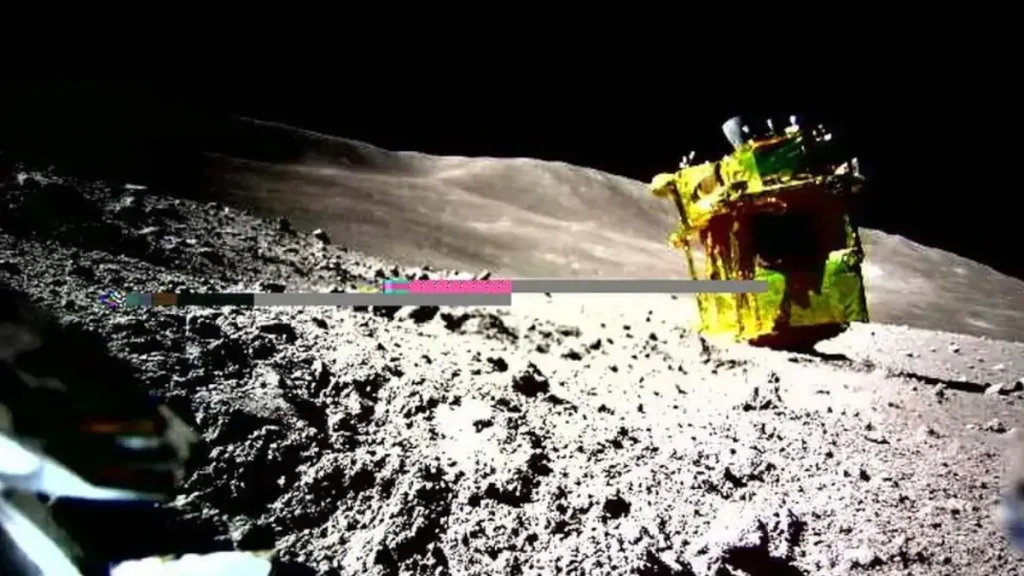
25. IM-1 Odysseus [United States, February 22, 2024, uncrewed]
Intuitive Machines IM-1 lunar lander, named Odysseus, a Nova-C class lunar lander developed by the American space exploration company Intuitive Machines (IM), was launched on February 15, 2024, reached lunar orbit on February 21, and landed on the lunar surface on February 22. This marked the first American spacecraft to execute a soft landing on the lunar surface in over 50 years, since Apollo 17 in 1972, and the first successful soft landing on the moon by a private company, following the failures of SpaceIL’s Beresheet in February 2019, ispace’s Hakuto-R Mission 1 in December 2022, and Astrobiotic’s Peregrine lander in January of 2024.
The landing did not go according to plan, as the spacecraft failed to relay images and data to the ground as expected. However, a weak signal was finally detected from the lander, at which point it was officially declared as a successful soft landing, and around two hours after landing, enough data was received to be able to confirm that it was upright.
Part of NASA’s Commercial Lunar Payload Services (CLSP) program, the lander carries six NASA-sponsored instruments, plus payloads from other customers, including the EagleCam CubeSat which was supposed to have been ejected during the descent at 30-meter (98 feet) above the lunar surface in order to record the landing of the Odysseus. At the time of writing it remains to be seen if this worked and whether any captured imagery can be relayed to the ground.
The Nova-C lands autonomously and is theoretically capable of taking off from the surface to relocate to a second location. Once landed, the Nova-C is designed to operate as long as it remains in sunlight (around 7 days) but is not designed to withstand the temperatures of a lunar night. This is in line with the recent Indian and Japanese landers.
26. Chang’e 6 [China, June 1, 2024, uncrewed]
Chang’e 6 is China’s second mission to return samples from the Moon, following the success of Chang’e 5. This mission aims to collect soil and rock samples from the Moon’s far side and conduct various scientific experiments on the lunar surface.
As with previous missions in the Chinese Lunar Exploration Program, the spacecraft is named after Chang’e, the Chinese Moon goddess. It was launched on May 3, 2024, and the mission duration is expected to be around 53 days. The lander successfully touched down on the lunar far side on June 1, 2024.
27. Blue Ghost Mission 1 [United States, March 2, 2025, uncrewed]
Blue Ghost Mission 1 is a robotic Moon landing mission led by Firefly Aerospace, marking a major milestone in commercial lunar exploration. Launched on January 15, 2025, and successfully landing on the Moon on March 2, 2025, at 8:34 UTC, it made Firefly Aerospace the first commercial company to achieve a successful lunar landing.
As part of NASA’s Commercial Lunar Payload Services (CLPS) program, the mission carried ten scientific investigations and technology demonstrations designed to support future human exploration of the Moon within the broader Artemis program. After years of development and testing, the Blue Ghost lunar lander was launched aboard a SpaceX Falcon 9 Block 5 rocket, sharing its journey with the Hakuto-R Mission 2 lander from Kennedy Space Center.
Designed for a soft lunar landing and an operational lifespan of 60 days, the Blue Ghost lander delivered a 94-kilogram (207 lb) payload to Mare Crisium, a vast 500-kilometer-wide (310 mi) lunar basin. The mission’s objectives include:
- Analyzing lunar regolith properties
- Studying the Moon’s geophysical characteristics
- Investigating interactions between the solar wind and Earth’s magnetic field
The lander is equipped with advanced scientific instruments, including a regolith adherence characterization device, a lunar retroreflector for precision distance measurements, a radiation-tolerant computer, and thermal exploration probes, among other key payloads.
This landmark mission represents a significant step forward in commercial lunar exploration, paving the way for future robotic and human missions under NASA’s Artemis program.
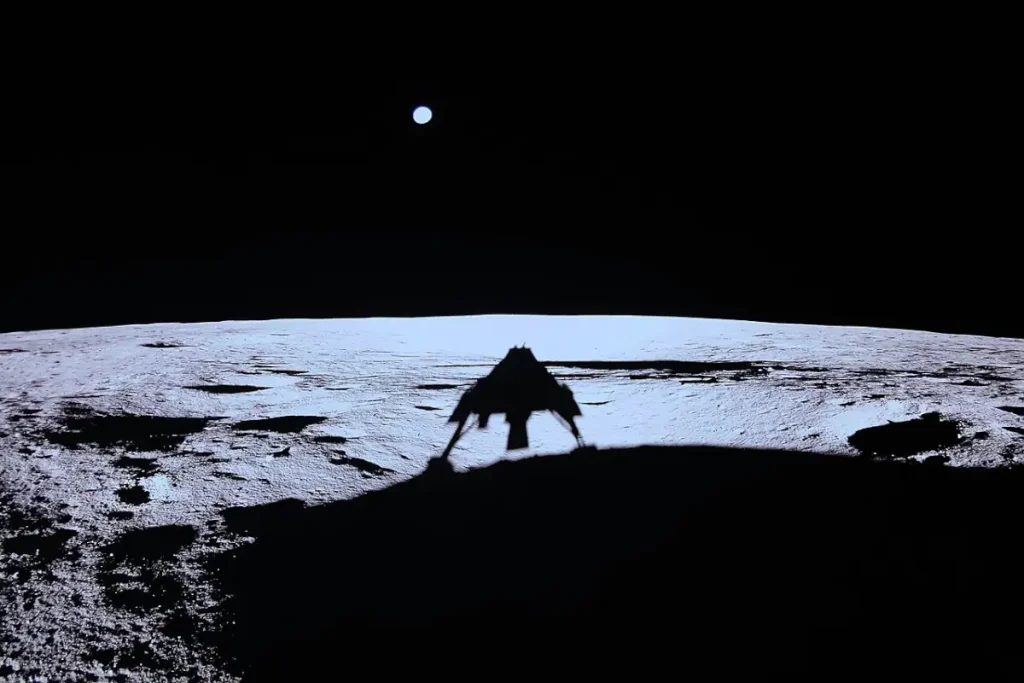
Notes
- In celestial mechanics, the Lagrangian points are positions in an orbital configuration of two large bodies where a small object affected only by gravity can maintain a stable position relative to the two large bodies. The Lagrange points mark positions where the combined gravitational pull of the two large masses provides precisely the centripetal force required to orbit with them. There are five such points, labeled L1 to L5, all in the orbital plane of the two large bodies. The first three are on the line connecting the two large bodies, and the last two, L4 and L5, form an equilateral triangle with the two large bodies. The two latter points are stable, which implies that objects can orbit around them in a rotating coordinate system tied to the two large bodies. Several planets have minor planets near their L4 and L5 points (trojans) with respect to the Sun, with Jupiter, in particular, having more than a million of these. Artificial satellites have been placed at L1 and L2 with respect to the Sun and Earth, as well as Earth and the Moon for various purposes, and the Lagrangian points have been proposed for a variety of future uses in space exploration.
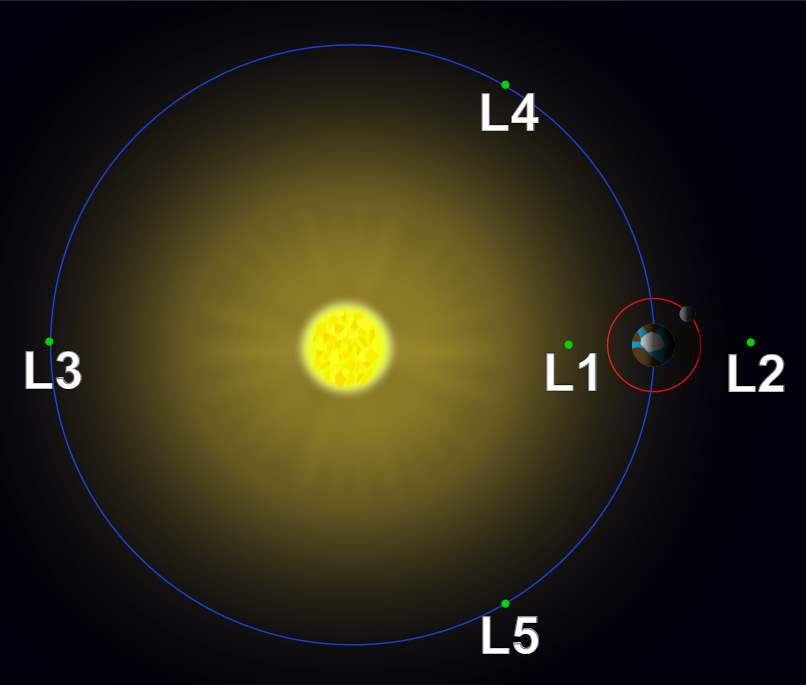
Sources
- List of missions to the Moon on Wikipedia
- Luna 9 on the NASA Space Science Data Coordinated Archive website
- Surveyor 1 Mission on the NASA Jet Propulsion Laboratory website
- Luna 13 on the NASA Space Science Data Coordinated Archive website
- “Footpads and Footprints: Humans and Machine Meet on the Moon” on the NASA Solar System Exploration website
- Surveyor 3 Mission on the NASA Space Science Data Coordinated Archive website
- Surveyor 5 Mission on the NASA Space Science Data Coordinated Archive website
- Surveyor 6 Mission on the NASA Space Science Data Coordinated Archive website
- Surveyor 7 Mission on the NASA Space Science Data Coordinated Archive website
- Luna 16 on the NASA Space Science Data Coordinated Archive website
- Luna 17/Lunokhod 1 on the NASA Space Science Data Coordinated Archive website
- Apollo 14 Mission on the NASA website
- Apollo 15 Mission on the NASA website
- Luna 20 on the NASA Space Science Data Coordinated Archive website
- Apollo 16 Mission on the NASA website
- Apollo 17 Mission on the NASA website
- Luna 21/Lunokhod 2 on the NASA Space Science Data Coordinated Archive website
- Luna 23 on the NASA Space Science Data Coordinated Archive website
- Luna 24 on the NASA Space Science Data Coordinated Archive website
- Chang’e 3 on the NASA Space Science Data Coordinated Archive website
- Chang’e 4 on the NASA Space Science Data Coordinated Archive website
- Chang’e 5 on the NASA Space Science Data Coordinated Archive website
- Blue Ghost Mission 1 on Wikipedia
- Firefly Aerospace’s Official Website
- Moon Landings: All-Time List [1966-2025] - February 2, 2025
- What Is Max-Q and Why Is It Important During Rocket Launches? - January 16, 2025
- Top 10 Tallest Rockets Ever Launched [2025 Update] - January 16, 2025
